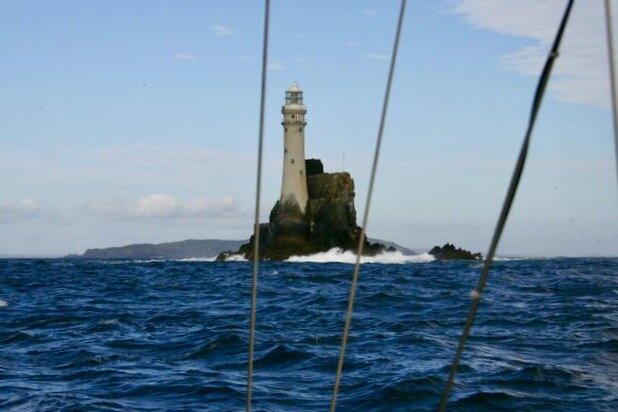Irish Road Tours is fortunate to overlook Long Island Bay and the Fastnet Rock. Here’s another extraordinary story from our blog
Fastnet
The most southerly point of Ireland lies eight miles south of the Cork coastline and four miles southwest of Cape Clear Island. The Fastnet Rock Lighthouse is an Irish icon, the most famous of all lighthouses and the only one to have a sea area named after it. The elegant Cornish-granite tower stretches taller and wider than any lighthouse in Ireland or Britain. It looks like an artist’s impression of what a lighthouse should look like, or something da Vinci might call The Vitruvian Lighthouse.
There isn’t a sailor in the world who hasn’t heard of Fastnet, or its fearsome reputation. Since 2017 it holds the record for the highest wind speed ever recorded in Ireland: 191km/h during Storm Ophelia. At the same time the nearby Kinsale Energy Platform recorded a wave of 26.1m (85.6ft). In 1985 a rogue wave smashed a section of glass 49m (160ft) above sea level, crashed through the light room and sent a vat of toxic mercury down the stairs. Even in calm weather a heavy swell around the Rock can make landing difficult and hazardous. It’s therefore remarkable that in 1921, during the War of Independence, a small party of Irish Volunteers carried out a surprising and audacious raid.
Cork brigades were no strangers to daring raids. Hostilities broke out in the county prior to the official outbreak of the War of Independence. This led to the brigades being better armed and organised than in any other county. Cork IRA units were the first to capture an RIC barracks, an entire British Army barracks and even a Royal Navy warship (though this was only temporary).
Lighthouses used gun cotton and detonators for fog signals, but they could also be used to manufacture road mines. IRA Intelligence revealed that surplus quantities were stored in lighthouses rather than land-based depots in the belief that they would be more secure. A successful raid on Mizen Head Fog Station in 1920 yielded significant quantities of gun cotton and detonators. British Forces were alert to a possible, albeit unlikely, raid on the Fastnet. To bolster defences the coastguard station in Schull housed well-armed Royal Marines, and every night the Royal Navy despatched a warship from Casletownbere to patrol the coast from Castlehaven to Bantry Bay.
Waves assaulting ‘the rock’
Despite these security measures, five men set out from Long Island on a Sunday afternoon in early June - the raid had been planned for the previous night but sea conditions were considered too dangerous. The party arrived on Cape Clear Island and met with six others, including Schull Battalion O/C, Sean Lehane. From a vantage point on the western tip of the island they watched the regular Royal Navy warship sweep up from the direction of Crookhaven, circle the Fastnet and head back towards Mizen Head. The little group of volunteers returned to their boat, the Máire Cáit, and finally put to sea. If intercepted they planned to explain themselves as fishermen, which was true for six of the party.
They slipped out of the North Harbour at sunset, turned southwest and made for the flash of the Fastnet light. An hour later the Máire Cáit approached the rock. It was now midnight and John O’Regan stepped onto the bow with a rope around his waist. “He’d to time his leap to a nicety,” said Sean O’Driscoll, O/C Ballydehob Company, “and as a lazy wave erupted its strength from the fathoms deep foundations of the rock, our boat rose high over the landing place”. He leaped from the bow, made the landing and quickly hauled in his companions. They made their way to the base of the lighthouse where they found an open door. Winding stairs led to the light-room above and it was here they discovered the keeper on duty. The remaining two keepers were brought into the lighthouse and sat down to talk. “We parleyed,” recounted one volunteer, “and Sean Lehane informed him that we had come for the guncotton”.
Long Island in the foreground
Once they gained access to the store they used the supply davits to load the Máire Cáit, a task made more difficult with the boat rising and falling with the swell of the sea. In half an hour they managed to seize seventeen boxes of guncotton and three of detonators.
With the boat loaded, the volunteers pushed off and set a course for Long Island, one of many small isles scattered between the mainland and Cape Clear. Seven miles of open water separated them from the relative safety of the shallow waters and hidden reefs that surrounded the islands. The Máire Cáit entered Long Island Sound just as the lights of the warship appeared once more in its sweep back towards the Fastnet. It was close but the timing couldn’t have been better. They put in at Leamcon, a famous pirate lair in the 17th Century, cached the haul and disappeared into the night. Several days later a ton of guncotton and detonators was distributed throughout the brigade.
Long Island and Long Island Sound (on a fine day)
This story, and many other extraordinary events that occurred during the War of Independence, may have been lost in time were it not for a condition of the government that obliged people to record their wartime activities in order to qualify for a state pension.
© David O’Neill 2018
Originally published in Ireland’s Own, May 2016




